Sweden came into this game having lost their two previous games in the UEFA Nations League. They were in last place of their group and needed to win to have a chance of staying in League A. Having France, Portugal, and Croatia meant it was a very tough group which is highlighted by this victory being their first. They do not depend on themselves to stay in the league as they will have to see what Croatia do in their next game.
However, they have an interesting team with the likes of Victor Lindelöf from Manchester United and Dejan Kulusevski from Juventus who could make the difference.
Having lost this game, Croatia are now on the same points as Sweden who are last in the group. They need to be careful because if they lose or draw the next game, Sweden will just have to win to stay in the league and relegate Croatia.
The 2018 World Cup finalists still have a great team, with the talent of Luka Modrić from Real Madrid and Mateo Kovačić from Chelsea among others.
In this tactical analysis, we will observe how both teams used their tactics to try and be superior. In this analysis, we will talk about how they pressed and how they attacked.
Lineups
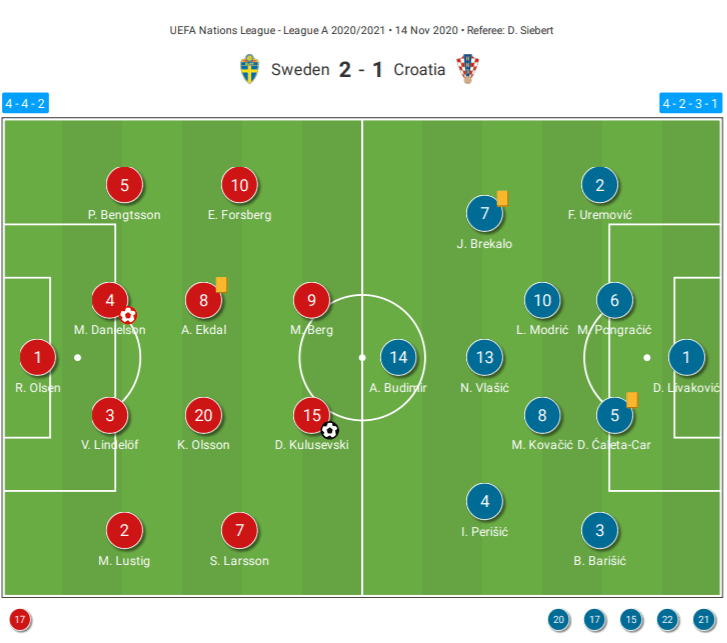
Sweden played in a 4-4-2, with Dejan Kulusevski and Marcus Berg leading the attack. On the sides were Emil Forsberg and Sebastian Larsson, with Mikael Lustig and Pierre Bengtsson as full-backs. The two midfielders were Albin Ekdal and Kristoffer Olsson. Dominating the defence were Victor Lindelöf and Marcus Danielson and Robin Olsen played in goal.
On the other side, Croatia played in a 4-2-3-1. Dominik Livaković started in goal, while the back four consisted of Borna Barišić, Duje Ćaleta-Car, Marin Pongračić, and Filip Uremović. The two pivots were Luka Modrić and Mateo Kovačić, with Nikola Vlašić as attacking midfielder. The wingers were Ivan Perišić and Josip Brekalo, having Ante Budimir as the reference in attack.
Croatia pressing
Having one striker usually makes pressing more difficult as there is one striker against two centre-backs. That means that if you want to press high, you will have to bring someone forwards and this might unbalance the team. This is why Croatia did not press very high but instead were in a medium-high block.
However, even when being in a medium-high block, if you do not pressure a centre-back, he has the opportunity to go forwards and create superiority where he goes. By driving with the ball, he will attract an opponent to him and this opponent will then have to leave his mark to do so, opening up options.
This is what happened to Croatia as they only had one striker to mark two centre-backs. In the image below, we see how much space the centre-back has in front of him. He takes advantage of this to go forwards and then make a dangerous pass through the middle as he had time and space.
In the image, we can also see Croatia’s medium-high block and how the striker tries to split the two centre-backs so that the one in possession cannot pass it to the other one.
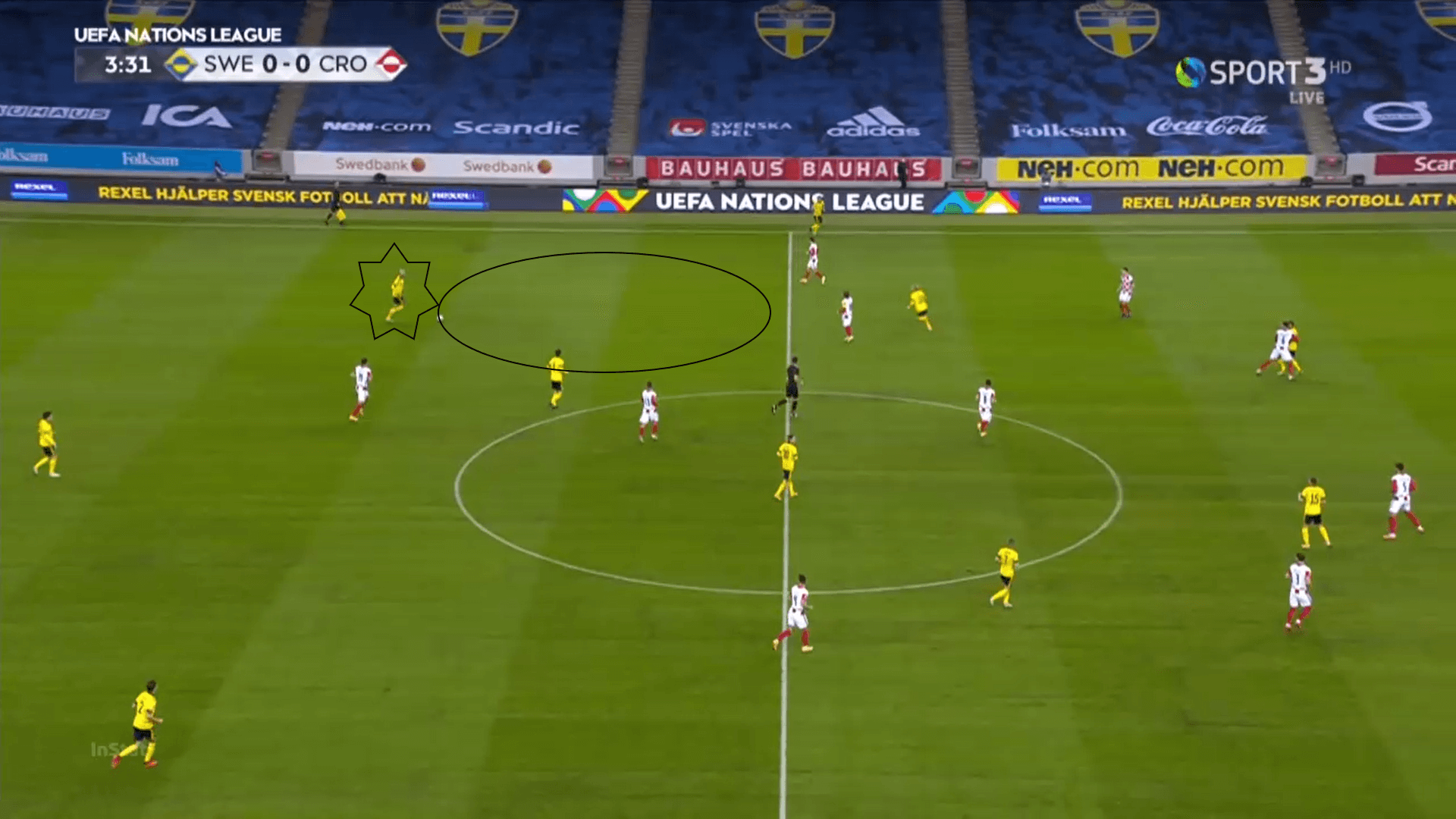
There were times when Croatia tried to restrict Sweden to one side but when they did so, they did not carry enough men to do this successfully. This made Sweden have superiority and they could play out with ease.
In the image below, for example, the Croatian striker has blocked the pass backwards, obligating the centre-back to only look for a passing option ahead of him. The attacking midfielder has come in to mark one of the midfielders who came to help. Then the left-winger is marking two players at once as the other Swedish midfielder had also come to help.
Thus, the attacking midfielder is marking the wrong man as the player he is marking has a very difficult task to receive the ball. Instead, he should be marking the other midfielder that the left-winger is marking. Due to this mistake, Sweden played the ball out easily.
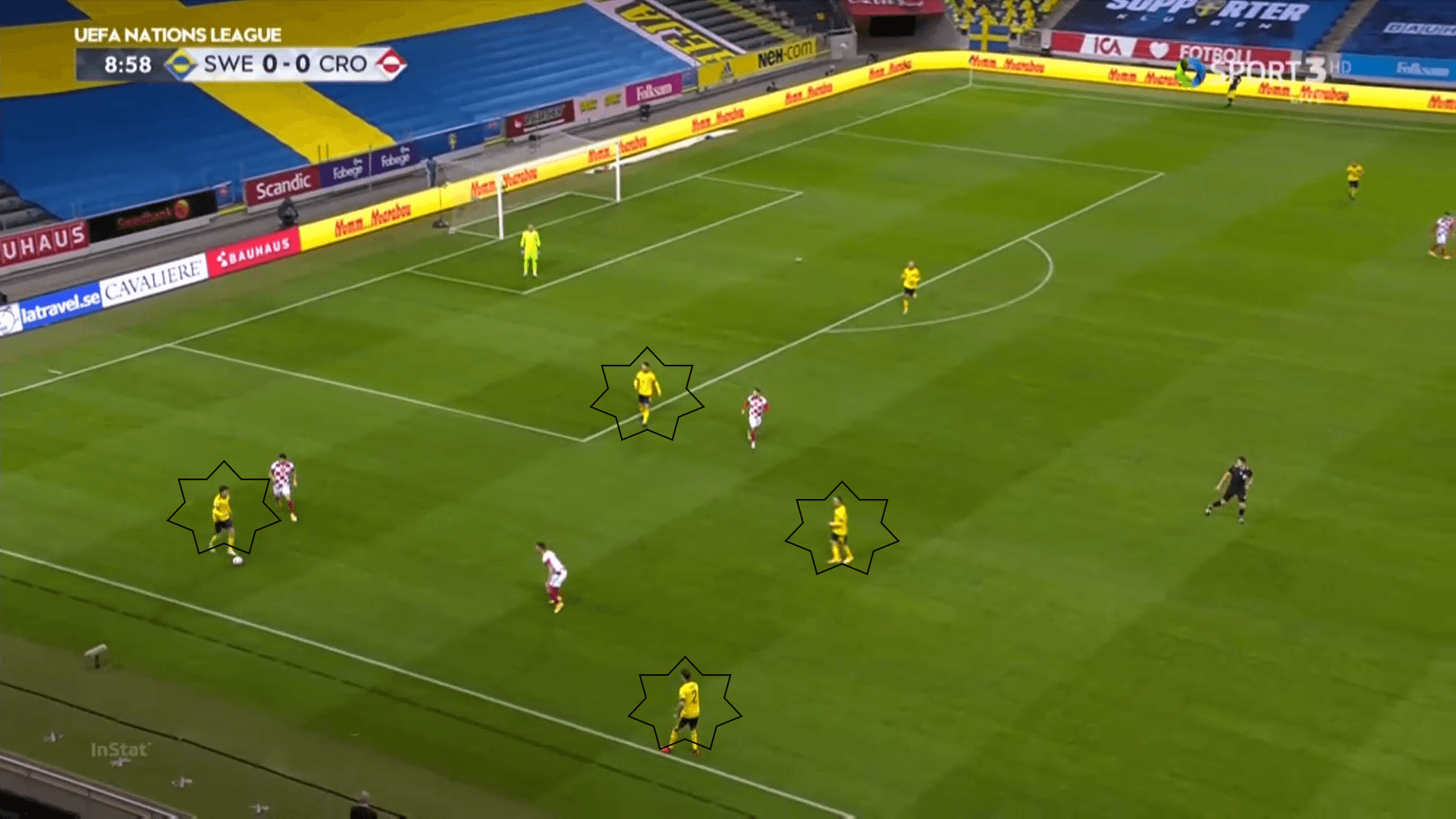
Their pressure was specifically not intense in the first half, with them having a PPDA of 32.8 in this half. PPDA means passes per defensive action which means that the lower the number, the more intense your pressure. This statistic is very high which showed how Sweden played the ball around with ease.
However, as they were losing in the second half, they became more intense and brought their PPDA down to 9.8, indicating their change in style.
Sweden playing out
Sweden were versatile in how they brought the ball out as they did not mind in playing it out neatly or being more direct. When the centre-backs did not find any good options close to them, they would send the ball up to their strikers who are powerful and could bring the ball down or header it.
Otherwise, they had several ways of playing it out. The first method was by their midfielders making intelligent movements. Since the Croatian pressure was not very intense in parts of the game, this made it easier.
The midfielder that was closest to the centre-back in possession would come and attract the pressure with him. Then, the other midfielder would open up by offering a diagonal pass to be alone and break off the pressure.
This is shown in the image below. The midfielder who is close to the centre-back in possession had just gone and done a one-two with the centre-back to draw the attacking midfielder to him. This then opened up space where the attacking midfielder used to be where the Swedish midfielder comes into and receives the ball with space.
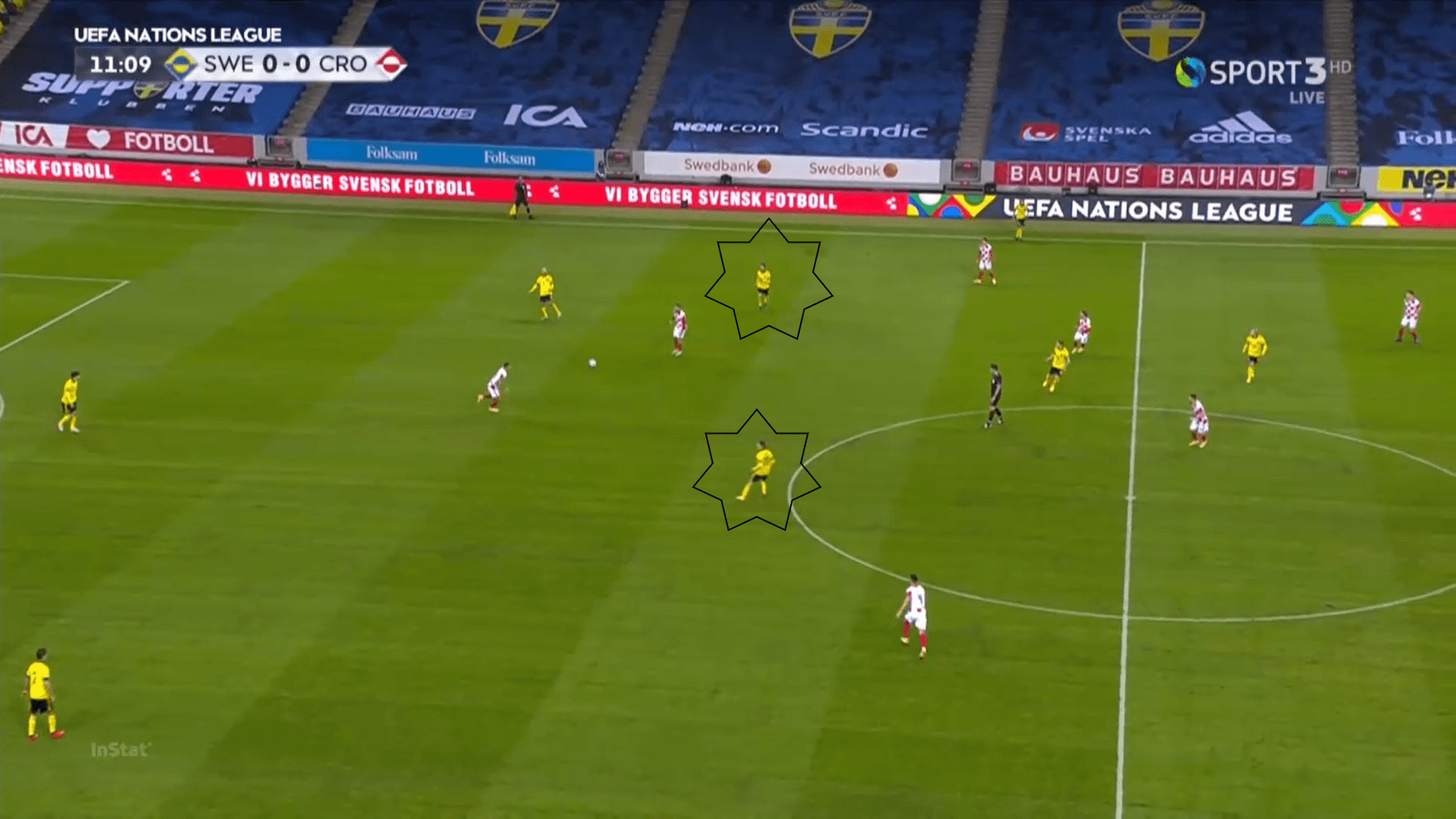
Another way they had to help play out with the ball was to switch the positions between the wingers and the full-backs. That way, the wingers would be in the full-back position to receive the ball and offer more technical ability and creativity in the build-up as the wingers are more technically gifted.
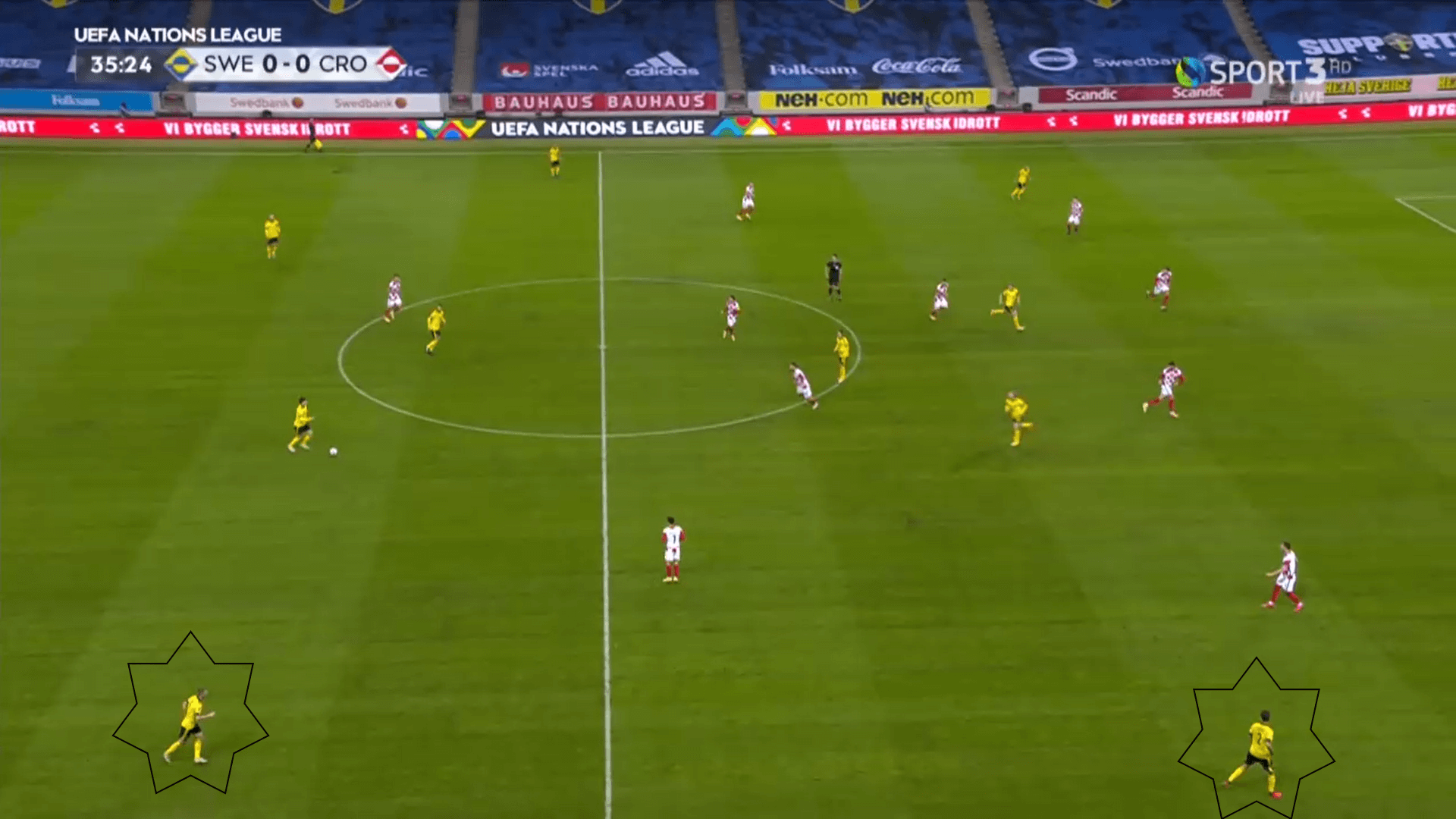
Lastly, they tried to surprise Croatia by making the left-winger come in as an attacking midfielder sometimes. He would then position himself in between lines to receive the ball through the middle. Therefore, Sweden tried more passes between lines when this happened.
This movement would surprise Croatia as throughout the game there was no one in that position and now all of a sudden there was. It would also surprise them because generally, in a 4-4-2 formation, teams tend to base their plays on the wings as they have two strikers to cross it to.
In this image, it is clear how the left-winger is exactly between the midfield and defensive lines. He is receiving a ball and is completely alone to turn towards goal and create danger.
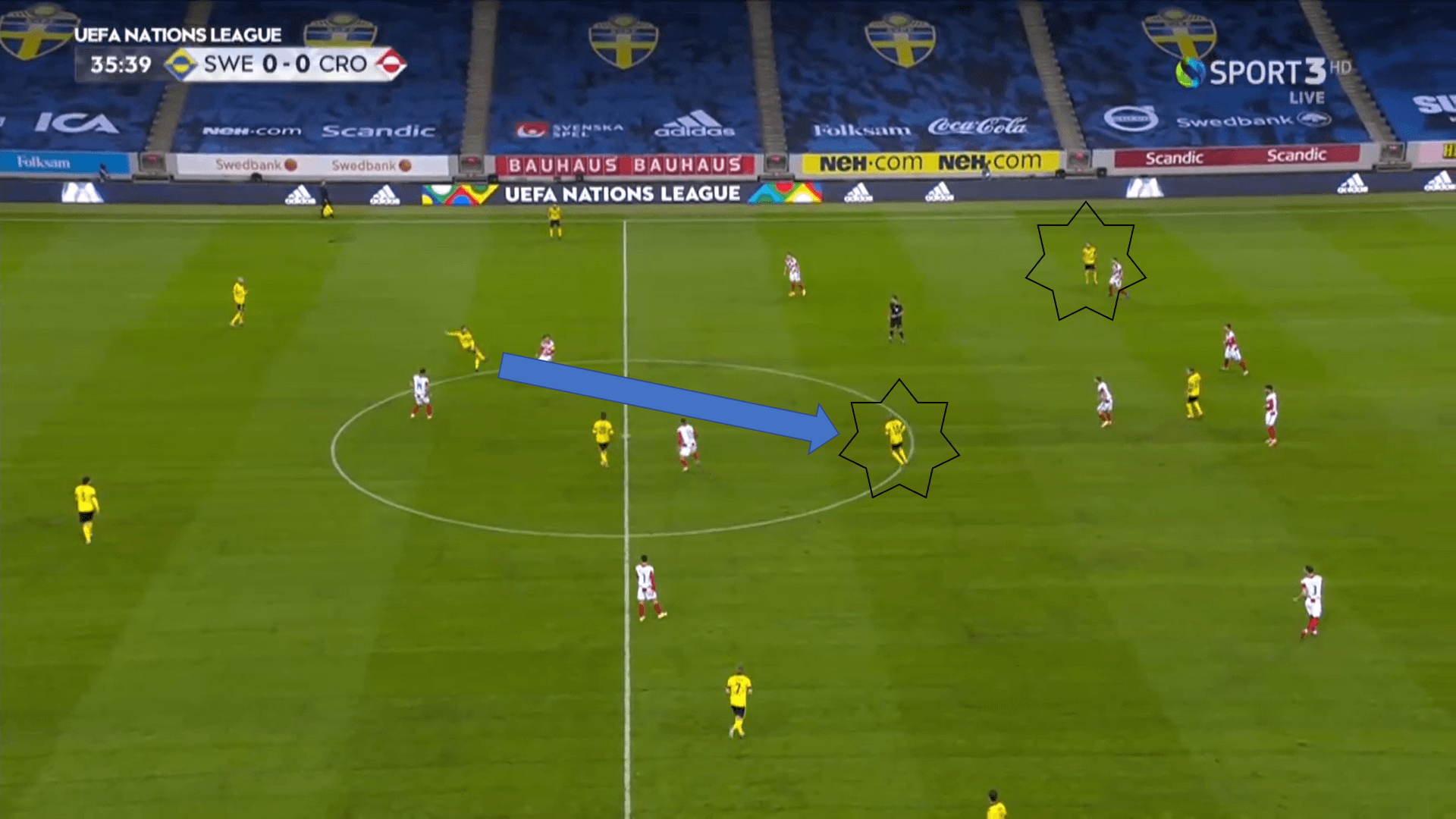
In some of these situations, Sweden would even switch the positions between the left-winger and one of the strikers. This is done to not concentrate too many players in one area as this would mean that there would be more defenders there as well to stop the play.
Sweden pressing
Sweden also did not press high but decided to stay in a medium-high block for most of the time. They let the Croatia centre-backs play around all they wanted between themselves. Because of this, they had to move their team side by side while remaining compact to not let passes through the middle. They did this efficiently as Croatia could only find passes out wide which is what Sweden wanted.
In this image, we can observe how the team is in a medium-high block and how the whole team is moving as one unit as the ball is passed to the left centre-back. It is only when they pass it to a full-back or try a pass through the middle that Sweden become more active in the pressure.
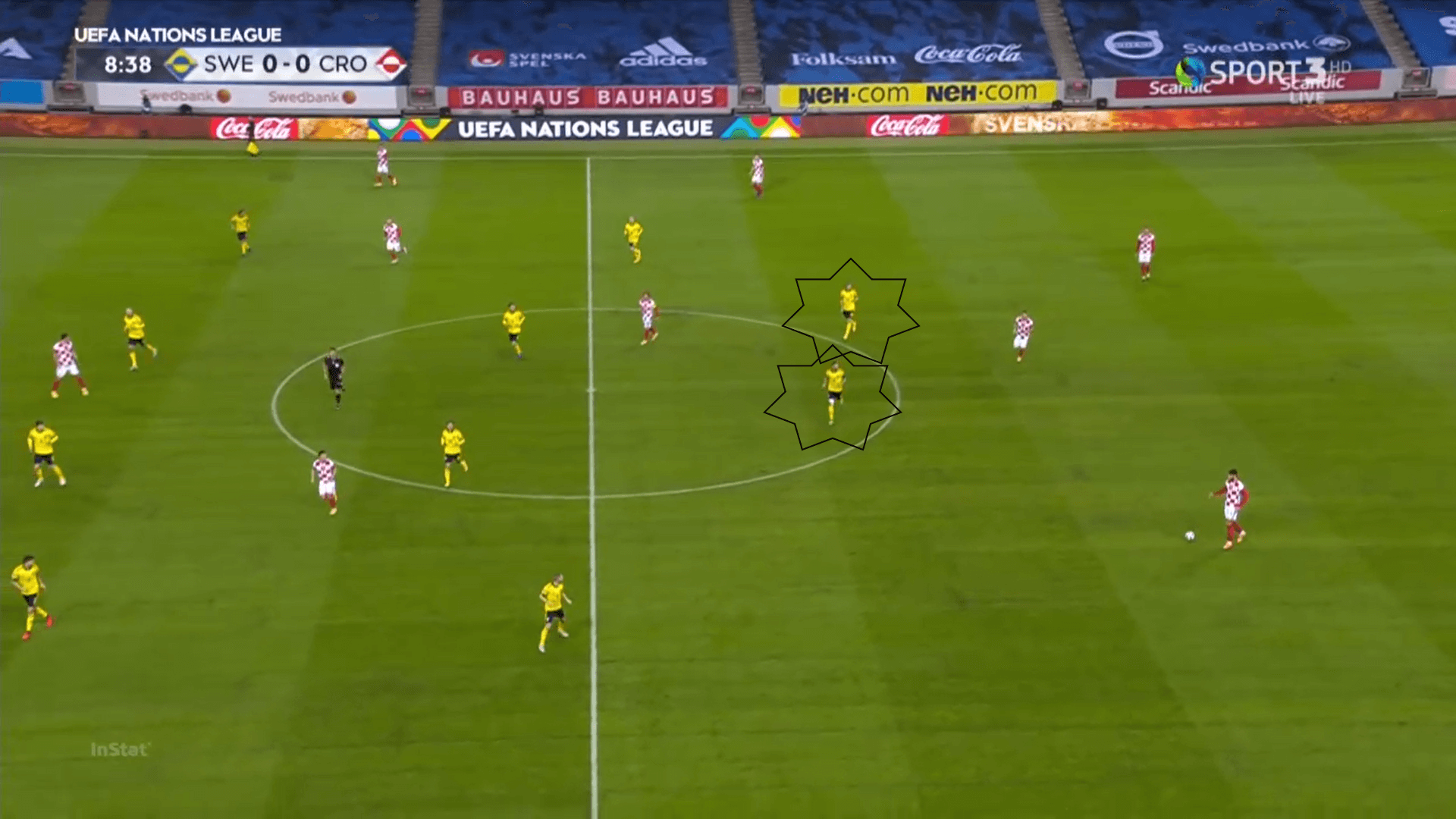
However, there were times when they decided to press high and when they did, it was done well. In the example below, we see how they are basically man-marking the Swedish players when pressing high.
Each striker has one centre-back and in the image, the right striker is going to the goalkeeper while cutting off the pass to the centre-back. Then, the two midfielders come up to mark the two Croatian midfielders who came to help. This obligates the goalkeeper to kick it forwards, where Sweden has a good chance of winning the ball due to their physical team.
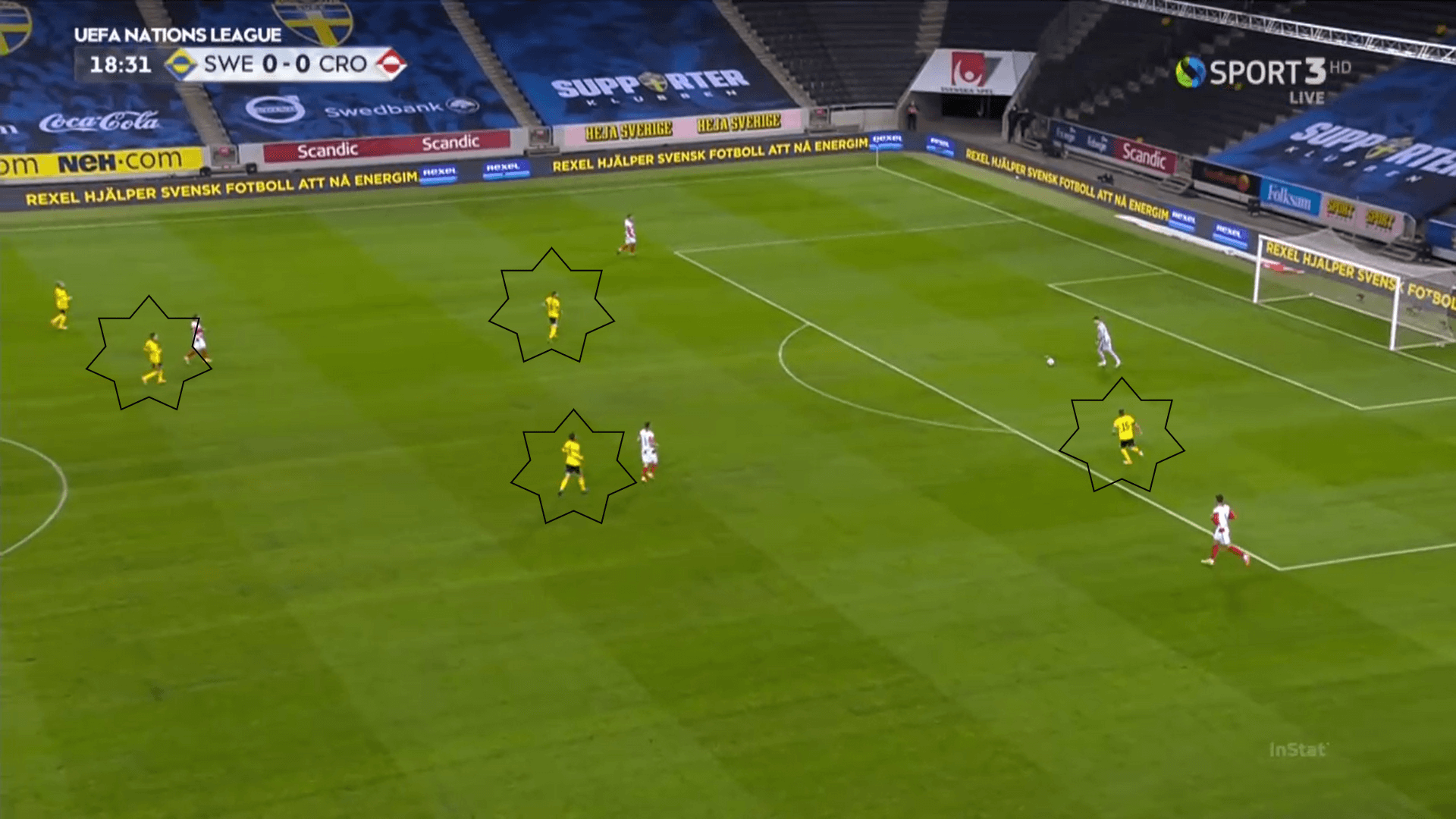
Croatia with the ball
Seeing as the centre-backs were having trouble playing the ball out effectively, Croatia made their midfielders come down to help. Even with them coming down, the Swedish strikers still did not go press intensely as the midfielders were in a position where they posed no danger.
The midfielders came down to provide more creativity in the build-up but this also took out the passing options in the middle. In the image, we can see how the middle of the pitch is just filled with Sweden players, with Croatia only having players on the wing.
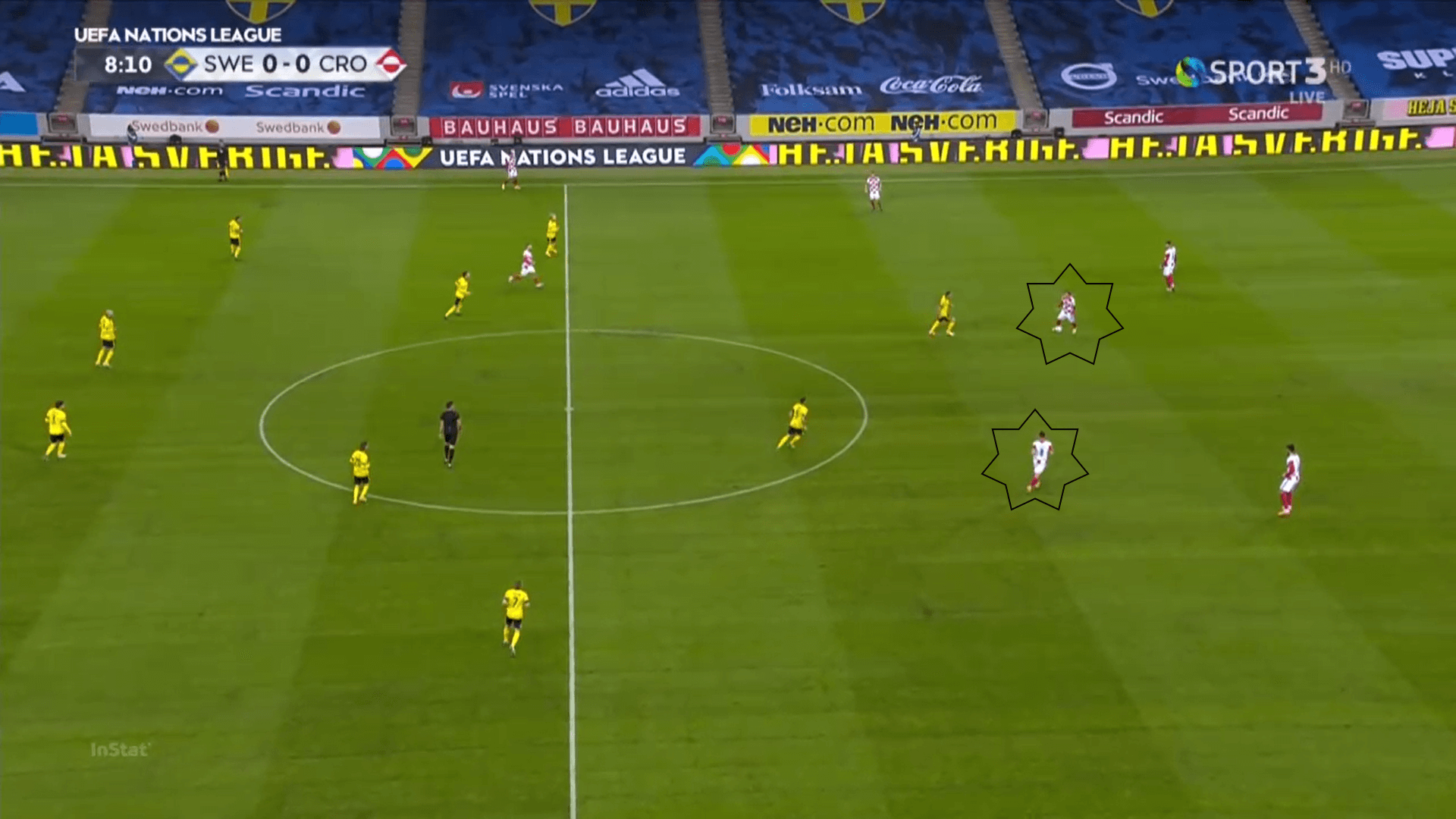
As Croatia were losing in the second half, they made their full-backs very attacking. By moving their wingers inside, it provided their full-backs with the whole wing to take advantage of. Moreover, the 4-4-2 formation is meant to be a compact team as mentioned before. This means that Sweden prioritised protecting the middle rather than the wing, which gave the full-backs even more space.
In the image below, it is clear how Croatia were emphasising their play on the wings as the right-winger saw no chances on his side and so switches the ball completely to the left-back who is alone. For Sweden, this is tiring as they had to continuously shift from side to side.
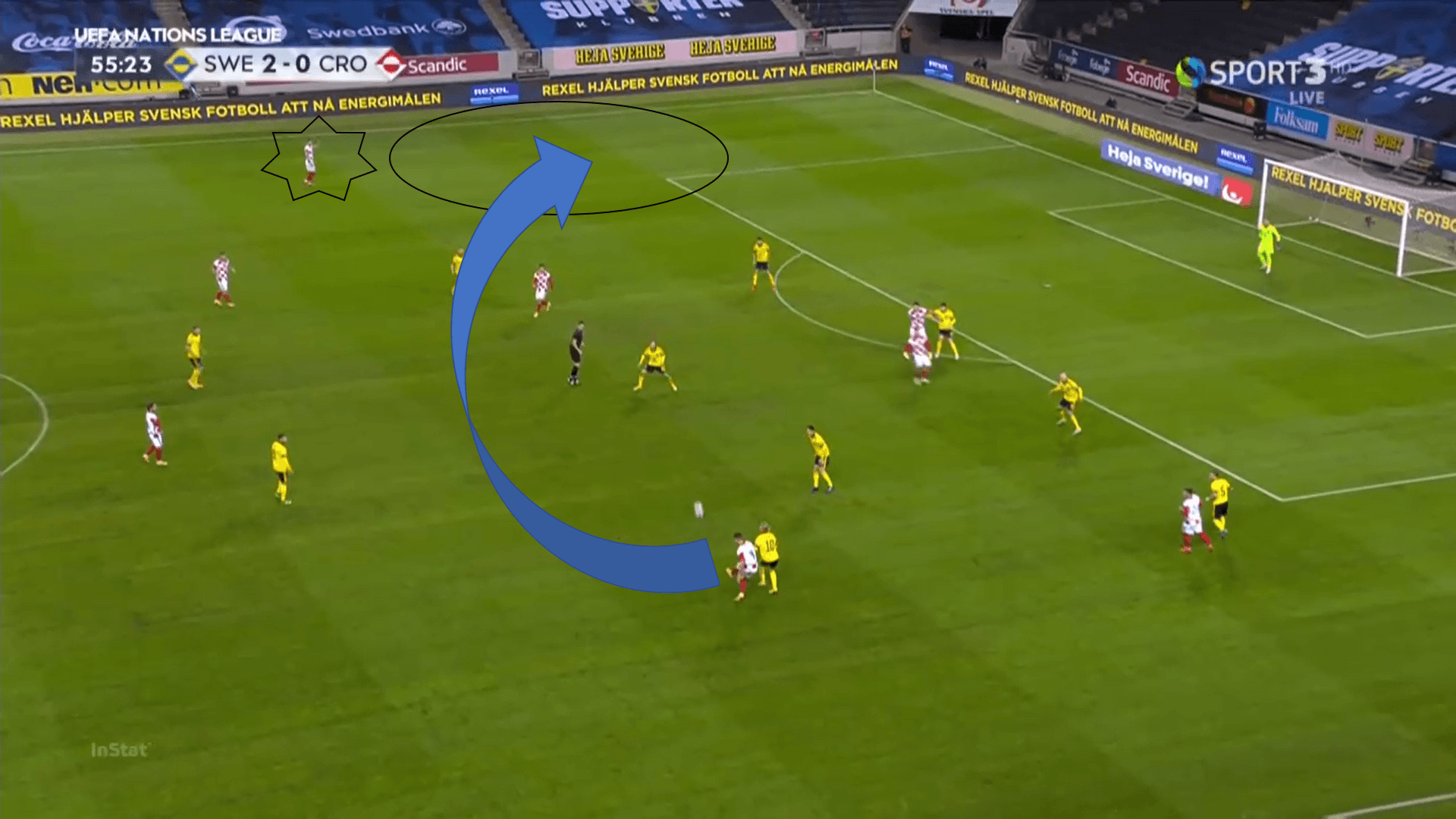
Furthermore, when the full-backs got the ball, the wingers took advantage of this and went into the box for the incoming cross. This way, they would populate the box with Croatian players to maximise the chances of finishing. Actually, their goal came from one of these crosses and a winger was the one who made the header.
Below, we can observe how the right-back is going to cross the ball and how the right-winger, striker, and attacking midfielder are all there to fight for it. Meanwhile, the left-winger has come to the edge of the box for the rebound.
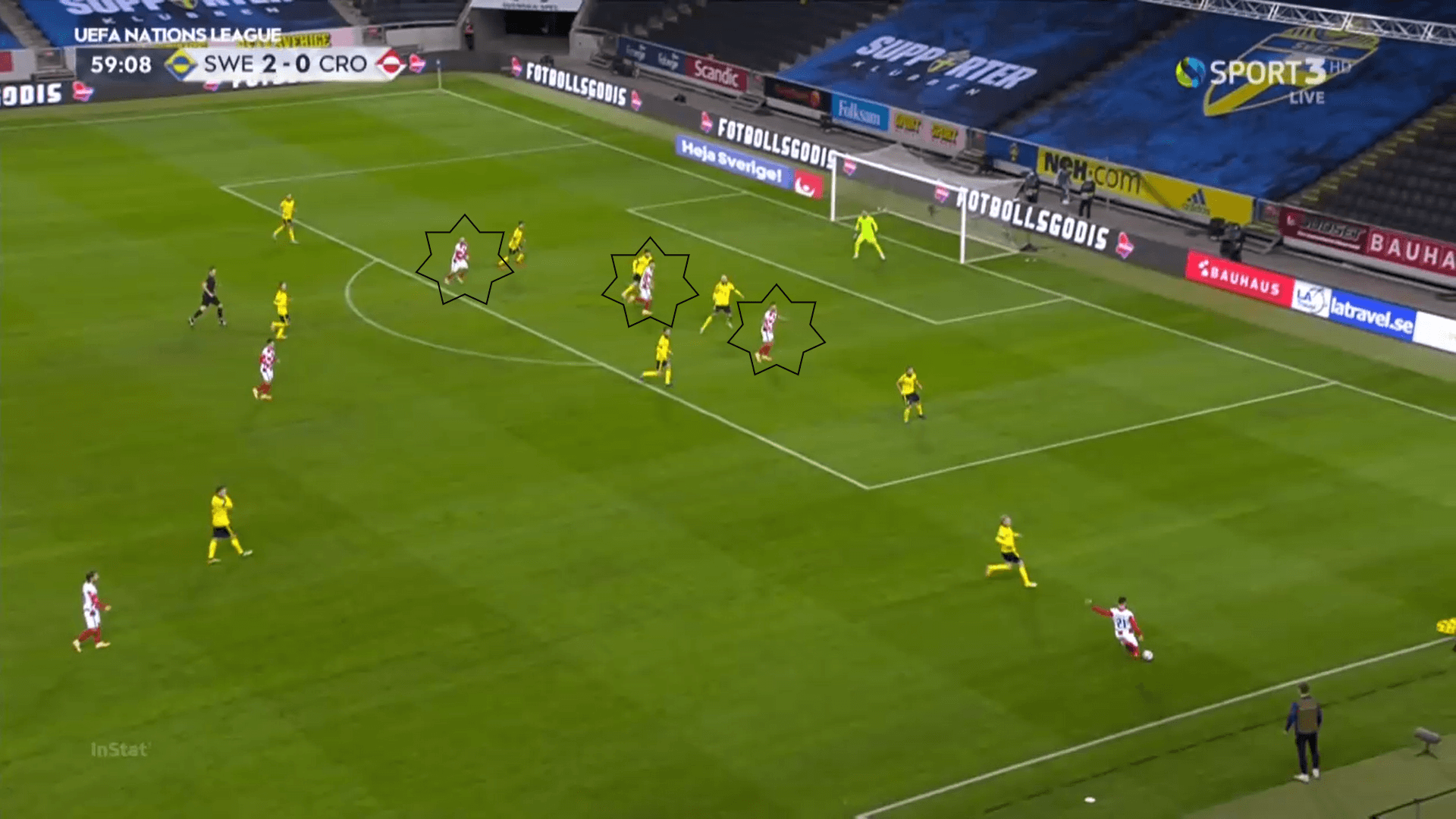
Conclusion
Overall, Sweden played a better game as they had more diversity in their ways of creating danger. Having a weak pressure created by Croatia also benefitted them when playing out. On the other hand, Croatia were struggling to build up as Sweden provided a compact team that barely allowed spaces through the middle. It will be interesting to see how they use this game to decide what to do in their next game, which is crucial for both of them.





Comments